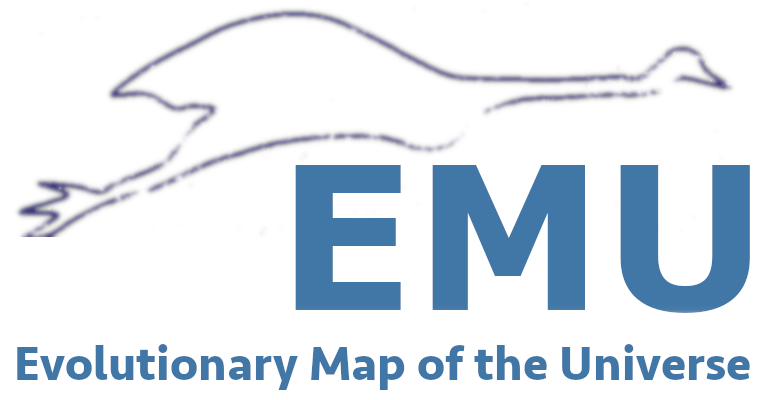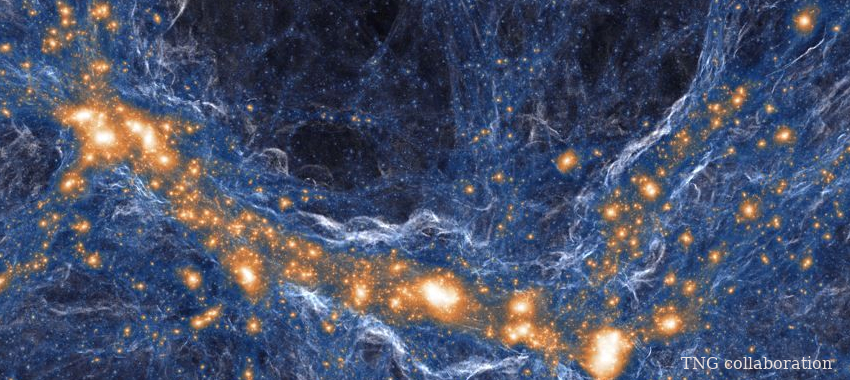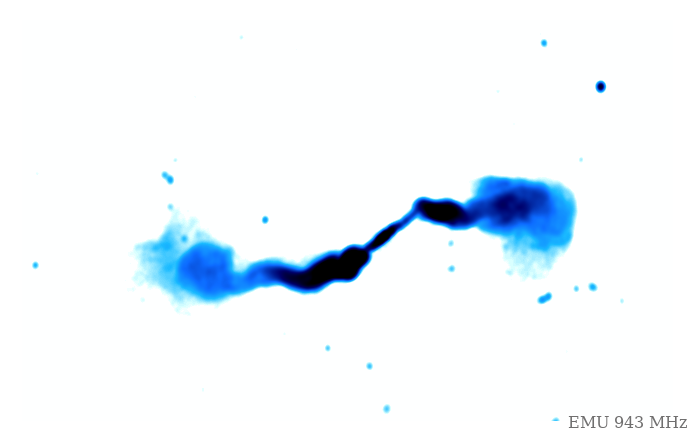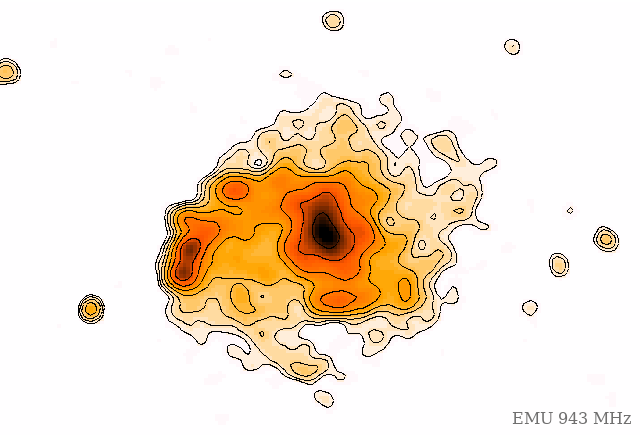


With the anticipated rms noise level of 10-15 microJy/bm over the whole Southern sky, EMU is expected to detect some 70 million galaxies becoming the first radio survey of such a scale. EMU aims to use the distribution of radio sources to explore the large-scale structure and cosmological parameters of the Universe.
EMU is expected to test fundamental physics; dark matter is one of the fundamental problems in modern cosmology as its existence is based only on indirect evidence. Another fundamental physics problem is the nature of gravity. While general relativity is consistent with observational measurements, it fails to fit into our theoretical understanding of other fundamental forces. EMU will allow us to perform independent tests of models of dark energy and general relativity inconsistencies through auto-correlation functions, integrated Sachs-Wolfe effect, and cosmic magnification.
Over half of the baryons in the Universe are now thought to be contained in the elusive Warm-Hot Intergalactic Medium (WHIM) - diffuse, low surface brightness gas and cosmic filaments are notoriously difficult to detect. ASKAP sensitivity, and its short baselines (20m, making EMU sensitive to angular scales of 1 degree), provide real possibility of detecting faint radio emission from the filaments of the large-scale structure (synchrotron cosmic web).
Galaxy clusters - the most massive gravitationally bound objects in the Universe - form at the intersections of cosmic filaments. Cluster haloes, relics (shocks from cluster mergers) and tailed radio galaxies all trace the evolutionary histories of the cluster structures. EMU aims to determine how radio sources populate dark matter haloes as a step towards understanding the underlying astrophysics of galaxy clusters and formation of the large-scale structure. We anticipate detections of numerous cluster radio haloes (few have been detected so far), population of clusters at redshifts beyond z=1, and network of weak shocks spreading throughout the clusters volumes.

Being located in the Southern Hemisphere, ASKAP has an
unparalleled view at our Milky Way and its centre. In fact,
for thousands of years the Australian Indigenous
inhabitants have looked up the night sky, which
became an important part of their culture. In the
Aboriginal astronomy the Milky Way hosts the
`EMU in the Sky', a unique `constellation' defined
by dark nebulae spreading across our Galaxy. This is
also where the name of our survey links to (see the
image on the front page of this website!).
In modern era Western astronomy, EMU aims to
create the most sensitive widefield atlas of Galactic
continuum radio emission yet made, uncovering
the complete set of stages of massive start formation
in the Galaxy. EMU will be addressing areas such as
star formation, supernovae, pulsars, planetary nebulae,
HII regions and the inter-dependency of dust, ionised
gas and triggered star formation, as well as the overall
Galactic structure. One of the largest sub-projects
within the EMU Galactic science is the
SCORPIO project (Umana et al. 2015).
Synergies: GASKAP
AGN play a major role in galaxy formation and evolution.
During their relatively short lifespan, they release
enormous amount of energy into their environments by the
means of relativistic jets. The peak of quasar activity
took place around z~2. At this point in time the star
formation activity was also extreme, and a non-negligible
fraction of AGN seem to be embedded in massive star
forming galaxies. At lower redshifts AGN seem to `downsize',
in a similar manner as SF galaxies. EMU will detect
radio-loud AGN over all observable redshifts, and will
allow us to investigate still unsolved issues in the
extragalactic astronomy such as the relationship between
AGN and SF activity, the AGN cosmic downsizing, the
relative contributions of different AGN feedback modes
to the evolutionary paths of galaxies. EMU will also
open a window on the radio-quiet AGN, and their evolution
out to redshift z=2. In addition, by being able to
identify numerous radio galaxies at very high redshifts
(z>4) EMU will also investigate the Epoch of Reionisation
(EoR).

Tracing when and where stars formed across cosmic time is one of the key questions in galaxy evolution. Radio wavelengths have an advantage over most other diagnostics (e.g. optical, IR) of star formation as radio luminosities are related to star formation rates and are unbiased by dust or molecular emission. Luminous starburst galaxies, with star formation rates around 100 solar masses per year will be detectable out to redshift z~2, and ordinary galaxies -similar to Milky Way (star formation rates of a few solar masses per year)- will be visible to z~0.3. With such data EMU will trace co-moving star formation rate density over the past 10 billion years, and thereby determine when most of the stars in the Universe formed.
Thanks to high surface brightness sensitivity of ASKAP,
and therefore EMU survey (~0.06K, which is well below
the median face-on surface brightness of a typical
spiral galaxy), EMU will detect nearly all resolved
normal spiral galaxies. The angular resolution of
approximately 10 arcsec (10 kpc at a distance of 200 Mpc)
will allow EMU to perform detailed studies of resolved
radio emission across galactic structures for face-on
galaxies, and extraplanar emission, winds and haloes for
inclined and edge-on galaxies in our near-by Universe.
Synergies: WALLABY,
POSSUM

The majority of discoveries in astronomy have been serendipitous stumbled upon by surveying the Universe in a new way, rather than by testing a hypothesis or conducting an investigation with planned outcomes. For example, of the 10 greatest discoveries by Hubble Space Telescope, only one was listed in its key science goals. EMU is significantly expanding the volume of observational phase space, hence our team is preparing for mining the data for the unexpected. However, the complexity of the ASKAP instrument and the large data volumes mean that it will likely be non-trivial to identify these 'unexpected discoveries'. This project explicitly aims to mine EMU data to explore an uncharted region of observational parameter space, and ultimately discover unexpected science that is not part of our primary science goals, using a variety of techniques and algorithms, and pushing the boundaries of machine learning methods for radio astronomy.
With the vast amount of data that the new-generation radio astronomy will provide, we will be facing new challenges in data analysis. The most fundamental problems that will need to be solved are self- and cross-identification of radio sources. Neither of these have been solved yet, and EMU together with SPARCS has a large group of scientists (astronomers and computer/data scientists) investigating this new field within the WTF project (Widefield ouTlier Finder, also called Discovering the Unexpected or We are Truly Flummoxed). All methods are being considered and tested, from simple Bayesian and likelihood match methods, to supervised and non-supervised neural network algorithms. Often learning sets (for supervised methods) are needed, and this is where our work in machine learning for radio astronomy draws on citizen science.
Up until now, self- and cross-identifications of sources
in large radio surveys have traditionally been performed
through visual inspections. While this is a manageable
task for a few thousands sources, it will be unfeasible
for millions of galaxies that EMU will detect. Automated
radio classification algorithms are still in the infancy
stage, while the delivery of versatile large training sets
of radio sources for the development of machine learning
techniques is now beyond the reasonable reach of single
scientists, and the most efficient way at present proves
to be through citizen science. Radio Galaxy Zoo - an
international citizen science project - has been
specifically designed as a pathfinder for developing
machine learning solutions for radio astronomy.
Pathfinder project: Radio Galaxy Zoo (RGZ)
Get involved:
Radio Galaxy Zoo: EMU is now up and running!
A challenge for EMU will be the lack of spectroscopic redshifts associated with the anticipated 70 million radio sources. Furthermore, it is expected that only 30%-70% EMU sources will have multi-wavelength optical/IR data that can be used to derive photometric redshifts (Norris et al. 2011).